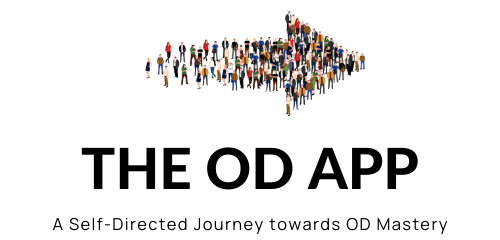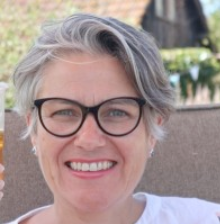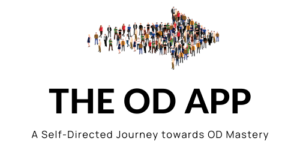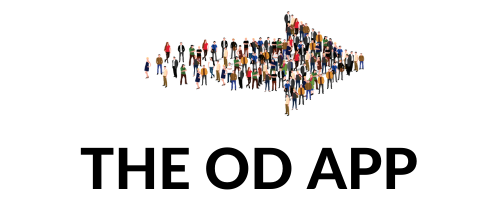Part 1 – Who I am (and my journey to Gestalt)
I first became aware of a Gestalt approach to OD when I participated in the NTL UK OD Certificate programme, in 2012. Mary Ann Rainey introduced us to the basic principles, and I was struck by her presence and the crispness and quality of her interventions. My curiosity continued to grow, and I attended the Introduction to Gestalt in the OD programmes run by Mary Ann Rainey and John Nkum. in 2016. In 2017 I joined the second cohort of the iGOLD (International Gestalt Organization and Leadership Development) programme run by the iGOLD Centre. This programme immersed me in the theories, principles, and practical reality of working with Gestalt at all levels of a system. It also introduced me to an amazing global group of Gestalt practitioners.
Since graduating, I have been on the faculty of the Introduction to Gestalt programme run by the iGOLD Centre.
Gestalt has had a profound impact on me and my work in OD. It has helped me to stay more grounded in the present moment, more aware of myself and what is going on around me, and much clearer in my intentions when working with clients. It has influenced how I approach my work at all levels of system, from coaching individual leaders to large-scale transformations.
Bringing Gestalt into our work, as OD consultants, gives us an opportunity to make a real difference with our presence. We can heighten our clients’ awareness of what is happening in the moment and that, in itself, can bring about change. It enables us to craft more powerful (and often simpler) interventions. It keeps the focus on the client and helps us to facilitate closure.
Part 2 – History of Gestalt OD
Loosely translated (from German), it is a term of psychology that means unified whole.
The term Gestalt is believed to have emerged in 1890, when Christian von Ehrenfels published “On Gestalt Qualities”, coining the term “Gestalt” from his work with Franz Brentano on perception.
The Berlin School of Gestalt Psychology played a critical role in advancing the field. They were researching visual perception in the early 20th century. They theorised that, as we see things, we organize, group, and connect them into meaningful forms, rather than as individual parts.
Two strands of Gestalt OD emerged from Gestalt psychology:
1. Organizational Context and Change – evolved from Kurt Lewin’s Field Theory, which recognized and emphasized the interdependent factors affecting individuals and organizations
2. Group and Team Development – evolved from the work of Fritz Perls and colleagues, regarding individuals, couples, and families
They were both intrigued by the Gestalt concept of ‘holism’ and saw promise in the application of Gestalt psychology to human behaviour.
The Gestalt approach to OD, as currently known, was pioneered by Richard Wallen at the Gestalt Institute of Cleveland. He was one of the first people to train with Fritz Perls and worked with students of Kurt Lewin in the early days of NTL. He was later joined by one of his students, Edwin Nevis, in using Gestalt concepts and methods. Edwin Nevis and Elaine Kepner were pivotal in creating the Organization and System Development (OSD) programme at the Gestalt institute of Cleveland, partnering with John D. Carter, Leonard Hirsh, and Carolyn Lukensmeyer.
With the combination of Gestalt Therapy, systems theory and OD, they set out to extend Gestalt practice beyond individuals, couples and families, and to develop OD practitioners who were skilled at intervening at all levels of systems. Their goal was to teach Gestalt Interveners to make a difference with their presence.
Principles and terminology used in Gestalt
Figure – Ground
In Gestalt psychology, a ‘figure’ is that which is in the foreground – that which is standing out, distinguished from the ‘ground’ that is the background. There may be several figures to notice, and, as we look from one to another, we need to choose what is uppermost or ‘figural’.
For example, when working with a group, we may notice that there are several relationships or topics that draw our attention, and our choice is to decide what is most figural or to help our client decide what is most figural.
Organism /Environment
Kurt Lewin believed that neither nature (inborn tendencies) nor nurture (how experience has shaped someone) account for human behaviour; rather, both interact to shape someone. He expressed the relationship between the person and the environment in behavioural terms as B = f (P, E) – Behaviour is a function of the person and the environment. Lewin referred to the space between the person and environment as the ‘boundary zone’.
This is critical in our work as ‘context is everything’ – we should always consider the individual, group, or system in its context.
For example, when I work with a team that is in an organization that is downsizing, I need to be aware that some of the behaviours I see will be different to when I have worked with that team in a time of growth and expansion. Environment is not an excuse for poor behaviour but helps us understand the whole picture.
Paradoxical Theory of Change (Arnold Beisser, 1970)
This theory espouses the view that we can only really change when we fully accept what/where we are now, rather than looking to the future of what might be. The future can only really happen when the present is embraced.
For example, an addict can only really address their addiction if they accept the fact that they are an addict. A leader can only move towards behaving in a different way when they truly accept the reality of how they are behaving now.
Perceived Weirdness Index (Jonno Hanafin, 1989)
This theory relates to how we show up with our clients. We need to be sufficiently different from the system to have an impact – but not so different that we get rejected by a system. This relates to the very intentional use of presence – How do we self-calibrate ourselves to work with different contexts and systems?
For example, I will choose to use much of the language that a system uses, but I will also intentionally try to bring something different that I see as missing in the system. That might be energy, if I feel energy is lacking in the system; or, it might be reflection if I feel that is missing. The key is not too much difference, but enough to have an impact.
Key Models used in Gestalt OD
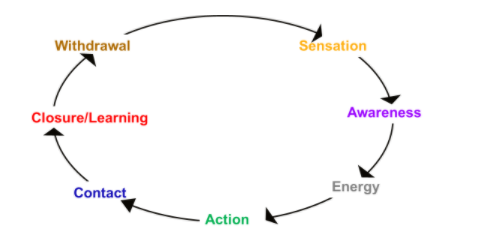
1. Cycle of Experience – enabling us to track the human experience. Developed at the Gestalt Institute of Cleveland, it is used to follow naturally occurring here and now phenomena.
Sensation – Sensing our environment through sight, sound, touch, taste, and smell – the ‘raw’ data that we pick up (without attributing meaning to it).
For example, when I walk into a room with a team, I begin to feel a sense of discomfort in my stomach, I hear periods of silence, I see some people talking to each other and others looking at their phones. I continue to observe as the meeting starts that some people are talking to each other and others are sitting in silence. Some team members are looking down at the floor.
Awareness – Where ‘figures’ form after sensing, scanning, and data collection. This can be naturally unconscious, so as a Gestalt Practitioner, we work to be more consciously aware and to raise awareness with our clients. Awareness is at the centre of Gestalt Practice and places emphasis on the ‘here and now’.
As the session starts, I begin to make meaning of my sensations. There is a divide between the different functions in the room – people are feeling very differently about being in this meeting.
Energy – As the figure emerges, energy builds towards an action.
I start to weigh my options – What should I do and when? I feel there is something not being brought into the room.
Action – Where energy is mobilised into some action. This is where a choice is made about what to do or what not to do.
I make an intervention – an observation about what I am seeing and experiencing ‘I am feeling a bit of tension, I am curious about what is going on in the group’.
Contact – Where the change occurs: there is an exchange of energy at the boundary within the organism, between organisms, or between the organism and the environment.
The organism is different after genuine contact.
I notice some people looking up and some tentative contributions being made. I encourage others to speak and to listen to each other.
Closure/Learning – Finishing and completing and, when not possible, acknowledging what remains unfinished. It includes acknowledging what has been achieved, what learning has taken place, and possibly the identification of next steps.
The role of a Gestalt Intervener is to help bring about good closure.
As the conversation comes to a close, I ask the group what else might need to be said and for observations on how they are feeling now.
Withdrawal – Movement through the cycle is complete, for now or permanently. Energy and interest in this topic recedes and moves to the background.
In my mind I take a step back from that cycle and step back into a new phase of awareness.
2. Unit of Work
The Gestalt OD approach to planned change aligns with the cycle of experience.
Beginning – Sensation/Awareness
Middle – Action/Contact
End – Closure/Withdrawal
As a Gestalt Intervener, our focus is to move through units of work, ensuring that we bring things to closure. If we don’t move through the units of work, then energy may be left tied up in ‘unfinished business’.
If I stay only in the beginning (sensation/awareness) with a client, then I will not be able to move them through action to closure. If I get stuck in the middle (action, contact), there is a risk that we may continue to open up new pieces of work without moving to learning, change, and closure. A finished unit of work is a clearly bounded, coherent, and understandable experience.
There may be multiple units of work within a larger piece of work. For example, if I am working with a coaching client, the overall contract could be described as a unit of work; and each session, another unit of work.
For example, a relationship with a colleague or an intrapersonal issue could be a separate unit of work within that session. You will often hear a Gestalt Intervener ask, ‘Is that unit of work closed for you now?’ or ‘What else do you need to do to close that?’
3. Four Roles of the Gestalt Intervener
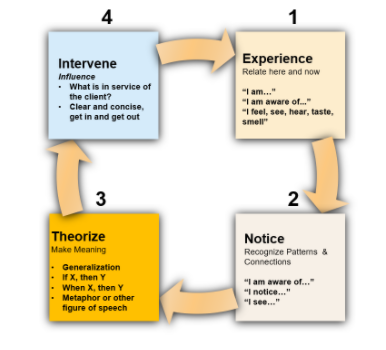
Experience – What is our ‘here-and-now’ personal experience of the situation? What is the raw data we are seeing, hearing, feeling?
For example, I am seeing one person in the group looking down at the floor, I am hearing another individual speak at the same time as someone else, I am feeling a sense of discomfort inside myself.
Notice – Recognising patterns and connections
For example, I notice that when person X speaks, person Y looks at the floor. I am seeing a pattern of person Z often interrupting person A. And I am aware that my feelings of discomfort increase when persons B and C are silent.
Theorize – Making meaning of what we have observed. What is our theory/hunch about what is going on? What metaphor might we use to describe what we are experiencing?
For example, when people are interrupted, it stops them from contributing. Or voices are being withheld because of unresolved issues. I see this group as teetering on a precipice and unsure of which route they should take.
Intervene – The opportunity to influence the group could be an intervention to an individual, several individuals, or the whole group. It could be a statement made to the group, it could be a question or a suggestion. And it could be an invitation to experiment. You should hold a clear intention of what you are trying to do and at what level of system.
For example:
‘It feels like this group is at a precipice and doesn’t quite know which path to take’ (using the metaphor with the group).
‘How are each of you feeling about the group right now?’ (a question to shift the dialogue and ask in order to hear from everyone).
‘Person Y, please talk to person X about how you feel and about what they are saying’ (an intervention aimed at two people, to uncover the dynamic and to explore feelings and impact).
‘Would you be willing to try an experiment, to experience what it would be like if everyone spoke up on this topic? (an invitation to experiment)
The challenge for the Gestalt Intervener is to use all of these roles. We may each have a preference for one over others. I know, for myself, I can be too quick to make meaning and move to intervention. Have I really got sufficient data to make meaning? Do I have a clear intention before I start the intervention?
A Gestalt Stance
As a Gestalt OD practitioner, I have a clear stance that I bring to my work with clients. A ‘stance’ is an approach to my work that puts the theory above into reality. It is effectively a set of guiding principles that inform how I work and how my clients should experience me as a consultant.
Here are some of the elements that sit at the heart of my stance, which are drawn from the iGOLD programme.
– To establish a compelling and supportive presence by attending to and selectively sharing personal experience in support of the work of the client (four roles of the intervener)
– To notice and selectively share awareness of feelings, thoughts, and sensations – feel, see, hear, smell, taste
– To track client interest and mobilization of energy so that action can take place
– To support completion of units of work and heighten the awareness of the client of the process in working through the cycle of experience and completing
Part 3 – What makes a good Gestalt practitioner?
The following list is my view on what really makes the difference as a Gestalt Practitioner. It is based on my own experience, my observation of Gestalt practitioners at work, and reading many of the articles and books that have been written on the subject. It draws extensively from the teaching of the iGOLD Center.
- To bring a compelling presence to clients
This is about what comes from all of who you are – your thinking, your feelings, your behaviour, and the impact that you have. It needs to be interesting enough to the client to have an impact, but not so different that it can be rejected. It requires a level of understanding of oneself, confidence in who we are, and a curiosity to always be open to feedback and learning.
It requires us to be able to flex in order to bring what the client needs or is missing from the client system. - To be aware of what is happening in the here and now
This requires an ability to stay wholly present in the here and now. It is about having a heightened understanding of ourselves and of our filters, biases, and projections. It requires us to focus on the data that we are taking in through all of our senses, as well as our own feelings. We need to be clear on what is data and what is our meaning making of that data. - To be mindful of the whole and to support clients to think systemically
We need to constantly consider the whole – for the Gestalt practitioner, context is everything. We need to be able to think holistically. It requires in our sensing that we include the internal environment and subsystems, as well as the external environment and subsystems. We need to be mindful that any intervention we make in one part of a system may have an impact at another level or part of the system. We therefore must be very intentional about where and at what level of the system we will intervene to mobilise the greatest energy to achieve the desired goals.
- To intervene succinctly and with a clear intention
Following the cycle of experience and the four roles of the intervener – we make a clear choice about when we intervene and the intention behind our intervention. When we make an intervention, we must ‘get in and get out’ – making our observation, question, or invitation to experiment as clear and clean as we can, and then taking the attention away from ourselves by leaving this with the client. - To be at ease with offering questions and observations, rather than solutions or answers
Raising awareness can sometimes be enough to bring about change – so often our interventions may be an observation of data or a pattern that you have noticed. It is helping the client to see a ‘figure’ or to make sense of the data to see their own ‘figure’. As consultants, we can often feel compelled to bring solutions or to make sense of things for a client. In Gestalt, we can have more impact in helping the client to see ‘what is’. - To remain aware of and respectful of boundaries
Boundaries are visible and invisible lines of demarcation and separation between subparts of a system and between a system and the environment. They can be open or closed, thick or thin, deep or shallow, near or far. Boundaries between ourselves and the environment must be permeable enough to allow exchanges, yet firm enough for us to have our own thinking and action.
When we work with clients, we must be clear on our own boundaries – what is ours and what is theirs – what we are there to do and what we are not there to do. A central tenet of Gestalt is that learning occurs at the Contact Boundary. So, as a practitioner we must know where they are and be able to work with the discomfort that may come about from helping our clients to work at the edge of their boundaries.
- To stay curious about resistance
Gestalt is recognised for its distinct approach to resistance. It sees resistance as a source of energy and as a healthy sign of multiple realities and needs in a system. A Gestalt practitioner will lean towards resistance and be curious about what that resistance is telling us about what is going on for that individual, group or system. We also need to pay attention to feelings of resistance within ourselves – What do these feelings tell us about ourselves in interaction with the system?
- To help our clients move towards closure
Helping ourselves and clients to move through the cycle of experience and bring things to closure. Where it is not possible to get closure, it may involve acknowledging what is unfinished or incomplete, as this may bring about a type of closure. If we have too many open units of work, our psychological energy will be used up in all of those things that are incomplete. A Gestalt Practitioner pays particular attention to endings, ensuring that we are clear on what has been achieved, and assimilating any learning and identifying next steps.
Developing your skill as a Gestalt Practitioner takes time and practice. It may require a shift in mindset as well as refining our skills. For me it has meant both going back to the fundamentals of Gestalt, on a regular basis, as well as being reflective on my own work with clients. As with many aspects of Organization Development, there is always personal work to be done, in order to improve our practice, as well as having more knowledge and theory.
For example, staying curious about resistance required me to view resistance differently. I need to demonstrate a genuine interest in resistance and move towards it, when often my immediate impulse may be to move away from it.
Part 4 – Options for developing Gestalt expertise:
In my opinion, developing Gestalt expertise will undoubtedly enhance your skills and practice as an OD Consultant.
As with OD, one of the most important factors is to have a deep understanding of yourself and the impact that you have. Continuing to deepen your self-awareness through experiential learning, reflection, and by actively seeking feedback on your impact, is a key part of the development journey of a Gestalt OD consultant
Another important element is to enhance your awareness and be able to stay in the here and now. Building great awareness takes practice. Simple practices to centre yourself, before commencing any work with a client, can be very helpful, as can mindfulness practices to bring you back to the present if your mind wanders.
Practising and reflecting on our practice will also be beneficial. Tracking ourselves through the four roles of the intervener and being clear on our intentions around intervention. Then look at what happens – Did the impact match our intent? If not, what are we aware of what may have led to a different impact? What new data has now emerged? This is where journalling and harvesting the learning from our experiences can be so helpful in our development as Gestalt OD practitioners.
Gestalt OD development programmes
There are some great development programmes for OD consultants and leaders to learn more about Gestalt. The first two I have personally experienced, the others have been recommended to by OD colleagues.
Introduction to Gestalt in Organizations www.gestaltod.org (The iGOLD Center)
four-day programme introducing the key theories and principles of Gestalt:
- Use of self and personal presence
- Gestalt theory of working with resistance and the ‘paradoxical theory of change’.
- Basic skill practice applying Gestalt principles at multiple levels: individual, two-person/dyad, interpersonal, trio, group, organization, and larger social systems
- Gestalt stance on coaching, conflict management, working with groups and teams, navigating change in large complex social systems, and leadership development
- Pragmatics, benefits, and dilemmas of the Gestalt approach
iGOLD – International Gestalt Organization and Leadership Development Programme – www.gestaltod.org (The iGOLD Center)
The iGOLD Programme consists of five, week-long immersion modules designed to enhance and deepen the practice of Gestalt in organizations and large social systems. In order to deliver the most powerful experience, the program is tailored for an on-going cohort group, limited to 24–36 participants.
This program is open to aspiring and experienced leaders, managers and administrators, consultants and coaches and human resources professionals who are ready for their next developmental experience.
The program is run across five different global locations and includes sessions in:
- Gestalt approach to working in organizations
- The theory and practice of Gestalt leadership, consulting, and coaching
- Use of self and personal presence
- Organization and leadership development
- Managing complex change
- Systems theory
- Intervening at multiple levels of systems: individuals, two and three persons, groups, organizations and larger social systems
- Appreciating multiple realities and working with ambivalence and polarities
- Diversity, inclusion, belonging and social justice
- Working with resistance and the Gestalt paradoxical theory of change
- Using the Gestalt experiment at work
Relational Organizational Gestalt (ROG) Programme – www.relationalchange.org
ROG is a holistic and practical approach to facilitating organizational and individual change. It is informed by Gestalt psychotherapy, and the latest thinking in systems theory and complexity, as well as by other complementary theoretical concepts. The programme is structured around our SOS (SELF, OTHER, SITUATION) framework, which holds at its centre the importance of developing and nurturing ethical presence.
Gestalt in Organizations – www.gestaltcentre.org.uk
The Gestalt in Organizational Development is an insightful, niche, and intensive programme for senior leaders, managers, HR and OD professionals and coaches. It is a dynamic programme that will help you enhance your ability to shape organizational dynamics, generate meaningful engagement, grow outstanding teams, enable and to facilitate effective change and organizational success.
The programme uses the transformative power of the holistic, humanistic, and relational Gestalt approach, expertly combining theory with experiential learning and skills practice.
It provides participants with the understanding, tools, and practice to deepen awareness, delve into organizational dynamics and people, insightfully explore organizational ecosystems, tackle rigid patterns and blocked processes, and to create strategies for effective meaningful change, organizational growth, and high performance.
Part 5 – Resources
The resources listed below are all ones that I have found helpful in understanding Gestalt and enhancing my practice.
Organizational Consulting: A Gestalt Approach, Edwin C. Nevis
Gestalt Practice: Living and Working in Pursuit of wHolism, Mary Ann Rainey and Brenda B. Jones
People at Work: Gestalt methodology and management, Lars Marmgren
Facilitating Change in Groups and Teams: A Gestalt Approach to Mindfulness, Paul Barber
Relevance, History, and Strategies for Effective Groups: A Conversation with Mary Ann Rainey — Quality & Equality (quality-equality.com)
NTL Handbook of Organization Development and Change – Chapter 4 Use of Self in OD Consulting: What Matters is Presence – Mary Ann Rainey Tolbert and Jonno Hanafin (Download Article Here)
The iGOLD Center – www.gestaltod.org
The Gestalt Centre (UK) www.gestaltcentre.org.uk
Relational Change – www.relationalchange.org
Gestalt Institute of Cleveland – www.gestaltcleveland.org
